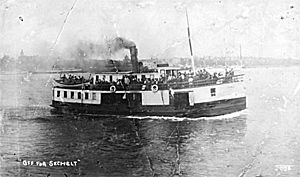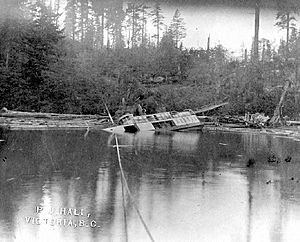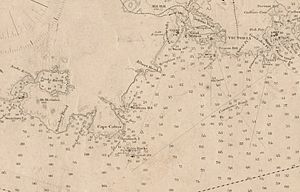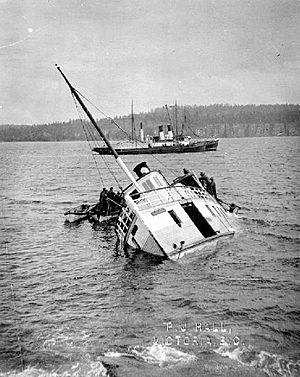Sechelt (steamboat) facts for kids
class="infobox " style="float: right; clear: right; width: 315px; border-spacing: 2px; text-align: left; font-size: 90%;"
| colspan="2" style="text-align: center; font-size: 90%; line-height: 1.5em;" | 
|}
The steamship Sechelt was a busy boat that sailed from 1893 to 1911. She traveled on Lake Washington, Puget Sound, and the Strait of Georgia. For most of her life, she was known as the Hattie Hansen. She became famous after she mysteriously sank near Race Rocks Lighthouse in 1911, with everyone on board lost.
Contents
- Building the Steamboat Hattie Hansen
- Adventures on Puget Sound and Hood Canal
- New Name, New Routes: The Sechelt
- Moving to the Strait of Juan de Fuca
| History | |
|---|---|
| Name | Sechelt (ex Hattie Hansen) |
| Owner | Hansen and Sons (1894 to 1903); J.F. Curtis & Sons (1903 to circa 1909); Sechelt Towage Co. (circa 1909 to 1911); British Columbia Steamship Co. (1911) |
| Route | Lake Washington, Seattle-Dogfish Bay, Hood Canal, Seattle-Poulsbo, Everett-Coupeville, Vancouver, BC-Sechelt, Victoria-Sooke |
| Builder | Lee Shipyard, Sand Point, Lake Washington |
| Launched | 1893, in Lake Washington |
| In service | 1893 |
| Fate | Sank 24 March 1911 |
| General characteristics | |
| Type | inland steamboat, passenger/freighter |
| Length | 83 ft (25 m) |
| Beam | 15 ft (5 m) |
| Installed power | steam engine |
| Propulsion | propeller |
| Notes | Insured for $9,000 on date of loss |
- Concerns About the Ship's Condition
- Worries About the Weather
- Owners Claim Ship Was Fine
- Recent Repairs and Inspection
- What the Inquiry Found
Building the Steamboat Hattie Hansen
The Hattie Hansen was built in 1893. She was made by the Edward F. Lee Shipyard at Sand Point, right on Lake Washington. Captain J.C. O'Connor ordered her to be used on the lake. But before she was even finished, O'Connor sold her. Ole L. Hansen bought her, and his family ran many steamboats on Puget Sound.
Adventures on Puget Sound and Hood Canal
Later in 1893, the Hattie Hansen was moved to Puget Sound. She traveled through the Duwamish River, which connected to Lake Washington back then. The Hansen family, her new owners, put her on a route from Seattle to Dogfish Bay. Captain J.J. Hansen was her first master on this route.
In 1898, she briefly carried mail on the Hood Canal route. After that, she returned to the Seattle to Poulsbo route. She stayed there until 1902. Captain Alf Hostmark was her last master on the Poulsbo run. In 1903, J.F. Curtis and Sons bought the Hattie Hansen. They used her on the Everett to Coupeville route. She ran there until a ferry named Whidby took over. Then, she was sold to a company in Canada.
New Name, New Routes: The Sechelt

Her new Canadian owners gave the ship a new name: Sechelt. This name came from a town, peninsula, and inlet in British Columbia. All these places were named after the Shishalh people, a First Nations group.
The Sechelt first sailed on the Vancouver to Sechelt route, up the Strait of Georgia. Captain Robert Reginald Clarke was in charge. Captain Leopold Arther Bernays also commanded her for a few months in 1910. That year, the Sechelt had some problems. She hit a reef near Vancouver harbor in August. Then, in November, she ran aground at Bowen Island.
Moving to the Strait of Juan de Fuca
New Owners and a Test Run
In January 1911, Captain H.B. James and his friend Harold Gray Jarvis bought the Sechelt. They were from Victoria. They started a company called the Sechelt Towage Company. Then, they brought the ship to Vancouver Island.
Captain James was new to running inland steamships. He had mostly worked on ocean ships before. James and Jarvis then created the British Columbia Steamship Company. They even rented a small ship called Tasmanian for a month. They wanted to see if a route from Victoria to Sooke would be popular.
Sailing the Dangerous Sooke Route
Sooke was a town with a safe harbor at the southern end of Vancouver Island. To get there from Victoria, the Sechelt had to cross the eastern part of the Strait of Juan de Fuca. This area was known for being very dangerous. In 1904, a much bigger and stronger steamboat, the Clallam, had sunk in almost the same waters. People in the shipping world knew about the Clallam's sinking. Some worried that the Sechelt was not strong enough for this route.
The ship had to pass through a narrow area between Race Rocks Lighthouse and the mainland. This passage was often risky, especially when the tide was going out. However, before James and Jarvis bought the ship, it had a big repair job. This was required by the insurance company and cost $6,000. The whole ship was insured for $9,000.
First Trip to Sooke
The Sechelt's first trip to Sooke was on March 1, 1911. She carried only four passengers and two tons of cargo. The weather was good, and everything went smoothly. On her return trip on March 2, she was taken out of service for some changes to her cabins. It also seemed she had lost a propeller blade on the trip to Sooke. Captain Caral Stromgren was supposed to be the regular master. But he only made that one trip. Captain James ended up making 18 trips on the Sooke run himself.
The Mystery of the Sinking
The Last Journey
On Friday, March 24, 1911, Captain H.B. James was in command of the Sechelt. She left Victoria harbor at 2:30 p.m. On board were her crew of four and about 33 passengers. Most of the passengers were workers. She also carried about 12,240 pounds of cargo, including heavy steel rails.
The ship stopped at the government quarantine station dock at William Head. About 13 passengers and some cargo got off there. The Sechelt then left the dock at 3:58 p.m.
Trouble at Sea
As the Sechelt sailed around Beechy Head, strong winds and big waves hit her. This happened in the Strait of Juan de Fuca. What happened next is not completely clear. Either her engine or steering system failed, or Captain James decided to turn back.
Eyewitness Account of the Sinking
The only people who saw the sinking were Henry Charles and his wife Anna Charles. They were First Nations people living on Beacher Bay Reserve. Henry Charles had a lot of experience at sea as a fisherman. He later described what he saw:
A week before last Friday (March 24th) about 5 p.m. I was sitting in my house looking out of the window to seaward when I saw a small steamer coming around Church Point going west. It was blowing hard from the west and big sea on into which the steamer was bucking. There was a strong ebb tide and heavy tide rips. The steamer was about 500 yards (460 m) off the small island when she was going southwesterly (South Bedford Island). When she had passed about 100 yards (91 m) west of the island she changed her course towards the American side about south straight. She was rolling then the sea being on her side. She still kept on going off for about five minutes. Then the first big sea struck her on the side (the right side) and made her lie on her left side about that much (indicating about 45̊) She still kept going towards where the big seas were, big breakers, when the second sea struck her and laid her over more. Then a third sea struck her and laid her over on her side. About two minutes after she came back on an even keel. I could only see the house then, I could not see any of the black part of the steamer's hull. She was then heading to westward. About a minute after that she sank down and I did not see any more of her; she sank quick. ...I have been here all of my life and know the waters well in this vicinity. A strong gale and the rips are very dangerous. The last I saw of the steamer was her smoke stack as she went down. I ran 2 ½ miles to the post office and told of the disaster by telephone.
Based on Henry Charles's story, investigators believed the Sechelt sank about 1.5 miles southeast of South Bedford Island. This was in very deep water. Everyone on board was lost.
Failed Rescue Attempts
After seeing the disaster, Henry Charles ran to Rocky Point. There was a telephone link there to the quarantine station at William Head. The station got the call at 7:56 p.m. They blew an emergency whistle. Five minutes later, Captain Thomas Riley took out the government steamer Madge to the scene. The Madge was always ready to go because it was a quarantine vessel.
When they arrived, they searched in the dark for about two hours. They looked for people or parts of the ship, but found nothing. The station also sent a small boat to Victoria. A tugboat called William Joliffe went to the wreck site. It was able to find one or two bodies, but other reports say no bodies were ever found. Parts of the ship washed up on nearby beaches. This included both of her lifeboats, still in their hangers. About 20 people were lost in the sinking.
Investigating the Wreck
A full official investigation was started to find out why the ship sank. Captain Charles Eddie, an expert from Vancouver, led the first part of the inquiry.
Concerns About the Ship's Condition
On March 30, 1911, Augustus Charles Kick, who had been the Sechelt's chief engineer, gave his testimony. He said the ship's bilge pumps were not good enough. He also said the ship took on a lot of water when the engine was running. This was likely because two of her propeller blades were missing.
The engineer thought the Sechelt was not stable unless it had enough heavy material (ballast) at the bottom. He also believed that if cargo was carried only on the main deck, it would make the ship even more unstable. He said he left the Sechelt for this reason. Kick described the weather on the day of the sinking. He blamed the sinking entirely on the ship's instability.
[A] heavy gale prevailed the whole of the day and would cause a heavy sea in the Straits, dangerous to most small craft even in thorough good working order and stability, which the Sechelt was not in my opinion.
Worries About the Weather
Captain Caral Stromgren, the Sechelt's "regular" captain, said he had been sick. That's why Captain James was in charge. Stromgren wanted to talk to Captain James on March 24. He went to the dock but found the Sechelt had moved. It was windy and raining hard, so he didn't think the Sechelt would sail. He decided to talk to Captain James later. He didn't find out until the next day that the Sechelt had sailed and was lost. He said if he had been in command, he would never have taken the ship out. He generally thought the Sechelt was in good condition, with a few exceptions.
Owners Claim Ship Was Fine
Harold Brown, who booked trips for the Sechelt, disagreed with the engineer. He believed a ship like the Sechelt could handle the sea conditions in the Strait. He said he had never seen the Sechelt out of balance.
Recent Repairs and Inspection
William Turpel, who owned a marine repair yard, said his company had pulled the Sechelt out of the water on March 14, 1911. They repaired her propeller. Because one blade was lost, they had to remove the opposite blade to keep the shaft balanced. In his opinion, without a lot of ballast, the boat was too tall and narrow to be good in rough seas.
Harold G. Jarvis, one of the owners who survived, said the opposite. He felt that the Sechelt was perfectly fine for the Victoria-Sooke route. He and Captain James had inspected her when she was out of the water. They both found her to be in "first-class" condition. He did not think the ship was top-heavy. He also said she had made several trips in worse weather conditions just before she sank. He described the weather on March 24 as "fresh" but not a strong storm. He said he was on the ship before it sailed that day. All the cargo was stored as low as possible on the main deck. No cargo was carried on the upper deck. He could not say why the ship was lost. But he thought it must have been a sudden accident or a mechanical problem. This would have caused her to turn sideways to the wind and lose control.
What the Inquiry Found
There is no clear record of what the inquiry decided. One expert says that no clear reason for the sinking could be found.
Other Ships That Sank Similarly
Less than three weeks later, on April 10, 1911, another steamer called the Iroquois sank. This happened in similar conditions in the Strait of Georgia. In that case, the ship's cargo was not stored well. It shifted when the ship hit a sudden storm. This time, there were survivors, including the captain. He was later found guilty of a serious crime related to the sinking. The same tugboat, William Joliffe, that went to the Sechelt wreck also went to the Iroquois wreck.
The much larger steamer Clallam was lost in January 1904. This was in waters near where the Sechelt sank. The weather conditions were somewhat similar. The Clallam's loss was mentioned during the investigation into the Sechelt disaster. In 1906, the Dix, a ship similar to the Sechelt, capsized and sank quickly after a collision in Elliott Bay. Although there were survivors, like the Sechelt, no lifeboats could be launched. Many people were trapped inside and went down with the ship.



